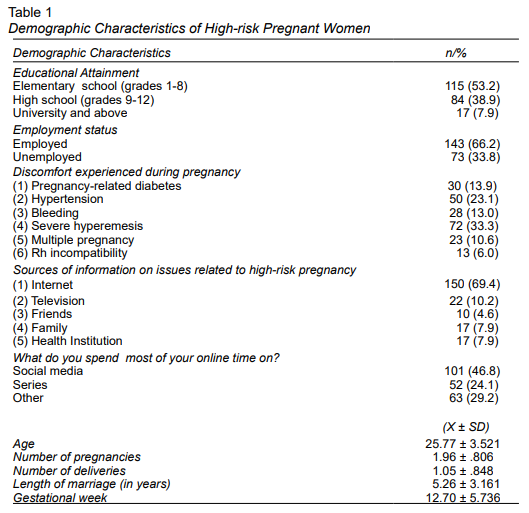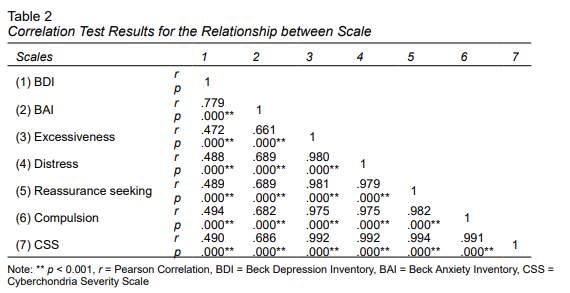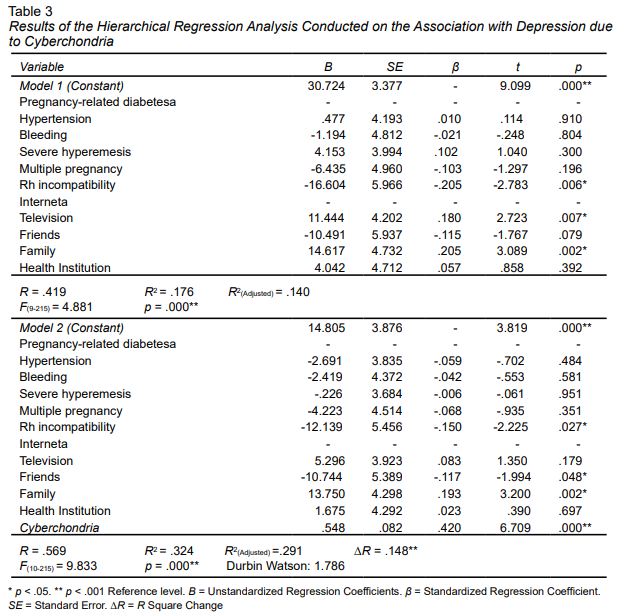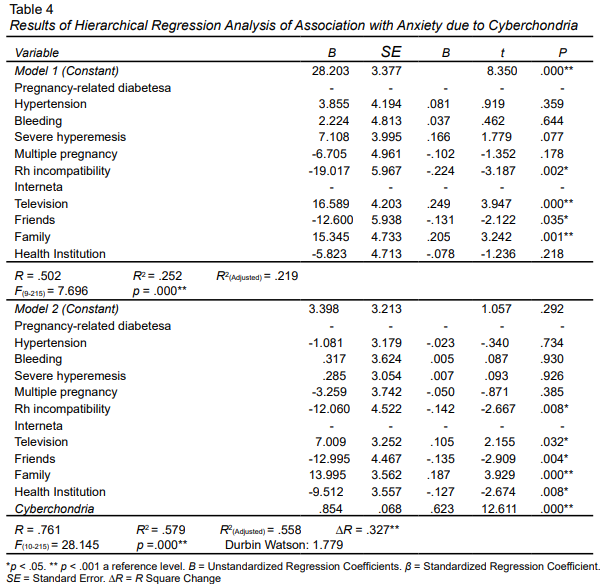INTRODUCTION
The psychological and physiological changes involved in pregnancy make it an extremely special, complex process in women’s lives (Bjelica et al., 2018; Davis & Narayan, 2020). The presence of physiological or psychosocial conditions threatening the lives or health of the mother, fetus, or newborn creates what are known as high-risk pregnancies (Çoban, 2016).
The conditions that make a pregnancy high-risk can lead to hospitalization, which in turn causes stress and anxiety for expectant mothers (Ölçer & Oskay, 2015; Bekmezci & Özkan, 2016). This can create significant physiological and psychological pressure in these women (Tiryaki et al., 2024; Koss et al., 2016), who may then begin seeking information from various sources on the risks to which they are exposed during this period.
The internet has become the most frequently used source of information on health problems. Excessive, uncontrolled information seeking produces a behavior pattern known as cyberchondria in certain individuals (Zheng et al., 2021). Cyberchondria is an uncontrollable behavior pattern that increases anxiety and distress levels due to health-related internet research (Starcevic & Berle, 2013).
Cyberchondria places a heavy burden on the health care system and is particularly dangerous for individuals living in underdeveloped regions (Starcevic et al., 2020).
Because over-evaluation of online information increases anxiety about one’s general health, cyberchondria causes excessive anxiety (McElroy & Shevlin, 2014). Various studies have reported that fear and anxiety are directly or indirectly linked to cyberchondria (Lin et al., 2020; Liu et al., 2020; Wu et al., 2021; Jungmann et al., 2020; Maftei & Holman, 202; Jungmann & Witthöft, 2020). Given that approximately 75% of internet users browse the web to identify symptoms of an illness they have, cyberchondria is a cause for concern (Bajcar & Babiak, 2021). Long-term internet use for health purposes has been found to be associated with a slight increase in depression (Bessière et al., 2010). Conversely, Starcevic & Berle (2019) reported a weak relationship between cyberchondria and depression and general anxiety. Arsenakis et al. (2021) found that depressive symptoms were also associated with cyberchondria. Cyberchondria was also reported to possibly affect psychosocial functioning and quality of life (Mathes et al., 2018; Rahme et al., 2021). Current research continues to explore the effect of online health information seeking on anxiety and depression. The literature was found to include no studies on the cyberchondria levels of high-risk pregnant women. The purpose of the present study is therefore to determine the cyberchondria severity levels of high-risk pregnant women and to examine its relationship with depression and anxiety. In addition to the general objective, the study includes the following specific objectives:
To examine the levels of depression, anxiety, and cyberchondria among high-risk pregnant women.
To investigate the relationships between cyberchondria, depression, and anxiety.
To compare psychological outcomes by high-risk pregnancy conditions and health information sources.
To determine the predictive effect of cyberchondria on depression and anxiety levels through regression analysis.
METHOD
This study used a descriptive, correlational design.
Participants
The study was conducted with high-risk pregnant women seeking treatment in the obstetrics and gynecology clinics of Bitlis Ahlat State Hospital between July and December 2024. The calculation made in the Open-Epi analysis program indicated the sample size as 214, with 90% power and a margin of error of .05 according to Cohen’s d .50 effect size value. The study sample comprised 216 high-risk pregnant women who agreed to participate in the study and were diagnosed with high-risk pregnancies. In this study, high-risk pregnancy was diagnosed by a physician specializing in the field of obstetrics and gynecology, based on a clinical evaluation. The classification was established in accordance with the clinical guidelines issued by the Ministry of Health of the Republic of Türkiye (Republic of Türkiye Ministry of Health, 2014). Medical risk factors such as heart disease, diabetes, hypertension, Rh incompatibility, threatened miscarriage, and pregnancy-related bleeding were taken into consideration. Only women who had been formally diagnosed with a high-risk pregnancy by a medical professional were included in the study. The inclusion criteria for the study were being ≥ 18 years old, able to communicate, literate, willing to provide consent to participate in the study, and having a high-risk pregnancy (such as heart disease, diabetes, hypertension, Rh incompatibility, risk of miscarriage, or bleeding).
Measurements
Study data were collected using the four forms listed below.
Personal Information Form. The form prepared by the researchers comprised a total of 17 questions (age, educational attainment, employment status, obstetric characteristics, discomfort experienced during pregnancy, sources of information concerning issues related to high-risk pregnancy, and daily internet use).
Beck Depression Inventory (BDI). Depression scores were evaluated using the BDI. The BDI includes 21 items, each corresponding to a specific category of symptoms and attitudes. It is scored on a scale from 0 to 3. In this study, the total score was used. The scale has a score range of 0–63, with higher scores indicating more severe depression. Hisli (1988) translated the inventory into Turkish and reported Cronbach’s alpha reliability coefficient as .80 (Hisli, 1989). The reliability coefficient was found to be .89 in this study.
Beck Anxiety Inventory (BAI). The 21-item BAI, developed by Beck et al. in 1988, is a self-assessment scale, translated into Turkish by Ulusoy et al. in 1998. Each item on the scale is scored from 0 and 3. Total scores range from 0 to 63, with an increase in the total score indicating an increase in anxiety symptoms (Ulusoy et al., 1998). Rather than providing a diagnosis, the scale seeks to determine the frequency and severity of anxiety symptoms experienced by individuals. Cronbach’s alpha reliability coefficient was found to be .93 in the reliability analysis of the scale (Ulusoy et al., 1998). This study found a reliability coefficient of .842.
Cyberchondria Severity Scale (CSS-12)-Short Form.The scale was developed by McElroy and Shevlin (2014) to assess cyberchondria, a form of anxiety characterized by individuals’ excessive searching for health information on the internet. The CSS-Short Form was developed by McElroy et al. (2019). The Turkish validity and reliability study was conducted by Söyler et al. (2021). The scale includes 12 questions scored from 1 to 5 points. The evaluation is based on the total score of the scale, ranging from 12 to 60. The scale is evaluated based on the total score. The higher the score, the higher the severity of cyberchondria. The scale has four sub-scales including excessiveness (min. 3, max. 15), distress (min. 3, max. 15), reassurance seeking (min. 3, max. 15), and compulsion (min. 3, max. 15). Cronbach’s reliability coefficient of the original scale and sub-dimensions was reported as .86, .83, .78, .65, and .76 respectively, and was found to be .90, .86, .90, .81, and .90, in the present study.
Procedure
Data were collected by interviewing the pregnant women face to face.
Statistical analysis
The data obtained in this study were analyzed using the SPSS 23 package program. Skewness and Kurtosis values were examined to determine whether the data follow a normal distribution. Descriptive statistics were analyzed using numbers, percentages, medians, means, and standard deviations. Pearson correlation analysis was conducted to examine the relationships between scales. While correlation findings align with the broader literature, they confirm that these associations are also found in high-risk pregnant women, a group with unique psychosocial vulnerabilities. These correlations were therefore reported not to demonstrate novelty, but to validate these well-established relationships within this specific population. Hierarchical regression analysis was performed to determine the predictive power of cyberchondria on depression and anxiety levels. One of the main assumptions of regression analysis is the absence of multicollinearity between variables.
In this study, variance inflation factor (VIF) values were examined to assess multicollinearity, with all VIF values being found to be below the recommended threshold of 10 (Hair et al., 2010). In addition, the Durbin-Watson statistics were evaluated to detect autocorrelation problems in the model, with acceptable values ranging from 1 to 3 (Field, 2009). The results indicate that the model met all assumptions, with no multicollinearity or autocorrelation issues observed, allowing for reliable regression analysis.
The significance level for the main variables of the study was p < .05.
Ethical considerations
Official permission was obtained from the Ethics Committee of the Faculty of Medicine at Kafkas University (dated 26.06.2024 and numbered 2024/06). Informed consent was obtained from the participating women, who were told they could drop out of the study at any time. The study adhered to the principles of the Declaration of Helsinki.
RESULTS
Table 1 shows the distribution of the descriptive statistics and demographic characteristics of the participants. Of the women who participated in the study, 53.2% had completed elementary school, and 66.2% were employed. A total of 33.3% reported having experienced severe hyperemesis during pregnancy. The most frequently consulted source of information regarding high-risk pregnancy was the internet, with 69.4% of pregnant women citing it as their primary resource. In terms of daily internet use, 46.8% of the pregnant women reported using the internet primarily for social media purposes. The average age of participants was 25.77 ± 3.521 years, the average number of pregnancies was .96 ± .806, the average number of deliveries was 1.05 ± .848, the average length of their marriages was 5.26 ± 3.161 years, and the average gestational week was 12.70 ± 5.736.
The results given in Table 2 show a highly significant, positive correlation between the BDI and the BAI [r(216) = .779; p < .001]. This result suggests that the anxiety levels of high-risk pregnant women rise alongside depression.
A positive, moderately significant relationship was found between the BDI, BAI, and CSS [r(216) = .490; p < .001; r(216) = .686; p < .001]. This result suggests that the depression and anxiety levels of high-risk pregnant women increase as their cyberchondria levels rise. An analysis in terms of sub-scales showed a similarly positive, moderately significant relationship (p < .001).
The results of the hierarchical regression analysis examining the association role of cyberchondria in depression are given in Table 3. In the model, demographic variables showing significant differences in depression (Health Problems Experienced during Pregnancy, Sources of Information on High-Risk Pregnancy) were included as control variables. In the first step, these variables were included in the model (Model 1), explaining 14% of the variance in the dependent variable (depression) (R2(Adjusted) = .140; F(9, 215) = 4.881; p < .001). It was found that blood incompatibility (β = –.205, p < .05), television (β = .180, p < .05), and family (β = .205, p < .05) were significantly associated with depression.
In the next step, the cyberchondria variable was incorporated into the model (Model 2). The inclusion of cyberchondria led to a significant increase in the proportion of explained variance (ΔR2 = .148; p < .001). Cyberchondria was found to be significantly associated with depression (β = .420, p < .001). In the final model, the independent variables accounted for 29.1% of the variance in depression (R2(Adjusted) = .291; F(10, 215) = 9.833; p < .001).
The results of the hierarchical regression analysis examining the association role of cyberchondria in anxiety are given in Table 4. In the model, demographic variables showing significant differences in anxiety levels (Health Problems Experienced During Pregnancy, Sources of Information on High-Risk Pregnancy) were included as control variables. In the first step, these control variables were entered into the model (Model 1). The control variables accounted for 21.9% of the variance in the dependent variable (anxiety) (R2(Adjusted) = .219; F(9, 215) = 7.696; p < .001). Blood incompatibility (β = –.224, p < .05), television (β = .249, p < .001), and family (β = .205, p < .001) were identified as having a significant association with anxiety.
In the next step, the cyberchondria variable was incorporated into the model (Model 2). The inclusion of cyberchondria significantly increased the proportion of explained variance (ΔR2 = .327; p < .001), and cyberchondria was found to have a significant association with anxiety (β = .623, p < .001). In the final model, independent variables explained 55.8% of the variance in anxiety (R2(Adjusted) = .558; F(10, 215) = 28.145; p < .001).
DISCUSSION AND CONCLUSION
Although platforms accessed through the web are recognized as being a significant source of information on health-related issues, they also contain a great deal of misinformation (Tarhan et al., 2021; Cinelli et al. 2020). Levels of internet use as a source of information during pregnancy were reported to range between 45.4% and 97% in Türkiye (Cirban & Özsoy, 2020). Experiencing a high-risk condition with a sense of uncertainty encourages first-time expectant mothers to seek information and use the internet more.
Online environments containing non-evidence-based data and a large amount of negative information may further increase anxiety in individuals with high anxiety levels (Abu Khait et al., 2023; Mrayyan et al., 2022; 2023). A study found that individuals’ health-related internet searches did not reduce their disease-related concerns and instead increased their depression and anxiety levels (Muse et al., 2012). Another study showed that health anxiety and anxiety sensitivity were features that contributed to the development of cyberchondria (Schenkel et al. 2021). This study found that high-risk pregnant women had high depression and anxiety levels and moderate cyberchondria levels.
Tiryaki et al. (2024) observed that mothers experienced moderate levels of cyberchondria. A study conducted with women of reproductive age (18-49 years) reported moderate levels of cyberchondria (Sezer et al., 2022). Another study conducted with women of reproductive age found that cyberchondria levels increased in keeping with their trait anxiety levels (Sezer et al., 2022). A study conducted of pregnant women indicated that women with health anxiety were more susceptible to cyberchondria. These results suggest that when pregnant women excessively engage in health-seeking behaviors, this may increase their anxiety levels, making them more prone to cyberchondria (Šoštarić et al., 2023).
In addition to the widely recognized role of internet-based information seeking, this study also found that high-risk pregnant women who relied on traditional sources such as television and family members for health-related information reported significantly higher levels of depression and anxiety. This suggests that the type and emotional tone of information, regardless of the source, may influence psychological outcomes. Unlike structured, evidence-based sources, these channels may convey emotionally charged or anecdotal content, potentially increasing feelings of fear and uncertainty. These findings underline the need for healthcare professionals not only to steer women toward credible digital resources but also to support them in navigating interpersonal and media-driven information environments that may amplify psychological distress.
This study also found that high-risk pregnant women who cited healthcare institutions and friends as their primary source of information experienced significantly less anxiety. Receiving information from formal medical sources and peer networks may provide more structured, reassuring, and emotionally supportive information, which can help reduce anxiety in vulnerable populations. Likewise, RH incompatibility was associated with lower levels of depression and anxiety, possibly due to increased awareness, and the timely diagnoses and more frequent medical check-ups these women receive.
This study found a significant relationship between the source of information concerning high-risk pregnancy and the discomfort experienced during pregnancy, and depression, anxiety, and cyberchondria. Research has documented that seeking health information may cause people to feel more anxiety and distress about their health (Baumgartner & Hartmann, 2011; Doherty-Torstrick et al., 2016). Those experiencing moderate levels of anxiety were reported to spend more time online than those who experienced mild anxiety. Online medical consultations increased their fear of illness. These individuals often browse two or more websites simultaneously because they do not find a single source of information to be sufficient (Akhtar & Fatima, 2019). Gioia and Boursier (2020) noted that while some cyberchondriac individuals may be particularly intent on finding reassurance in their search for online health-related information, repeated anxiety-raising behaviors can become addictive.
This study found that cyberchondria levels increased alongside high-risk pregnant women’s depression and anxiety levels. Starcevic et al. (2019) found that depressive symptoms were only minimally associated with cyberchondria. Arsenakis et al. (2021) reported that depressive symptoms were negatively associated with cyberchondria. Another study found that cyberchondria may affect depression in individuals with compulsive problems (Ambrosini et al., 2022).
The positive correlation observed between depression and anxiety, as well as the relationship between cyberchondria and anxiety, is consistent with prior research findings (Starcevic & Berle, 2013; McElroy & Shevlin, 2014). Although these relationships are well-established in the general population, their confirmation in high-risk pregnant women adds contextual value. Given the heightened emotional vulnerability and specific stressors experienced by this population, reaffirming these associations is important for developing tailored psychoeducational and clinical interventions.
In this study, cyberchondria was an association factor for depression and anxiety explaining 29.1% and 55.8% of the effect of cyberchondria on depression and anxiety levels in high-risk pregnant women respectively. Misra and Stokols (2012) reported that cyberchondria negatively affected general health and increased anxiety levels. Vismara et al. (2022) reported that patients with psychiatric disorders (such as major depressive disorder or anxiety disorder) had more severe cyberchondria symptoms. In this regard, the occurrence or presence of physical or psychological disorders may be a predisposing factor for health-related information-seeking and cyberchondria.
This study has several strengths. It is among the first to specifically explore cyberchondria in high-risk pregnant women, a vulnerable population often overlooked in mental health and digital behavior research. Moreover, the use of reliable, validated psychometric instruments enhances the robustness of the data. However, some limitations must be acknowledged. The cross-sectional design precludes any conclusions regarding causal relationships between cyberchondria, depression, and anxiety. Furthermore, data were collected using self-reported questionnaires, which may be subject to recall bias and social desirability bias. Another important limitation is the lack of an assessment based on whether the women were in their first, second or third trimester of pregnancy. Future research employing longitudinal or experimental designs, as well as mixed-methods approaches, and stratifying participants by trimester and type and severity of high-risk condition could provide deeper insights into the dynamic interplay between information-seeking behavior and psychological well-being in this population.
The study was conducted with a relatively small sample of high-risk pregnant women from a single state hospital in Türkiye, which may limit the generalizability of the findings to other populations or regions. The study reflects cultural and healthcare-specific factors in Türkiye, which may not apply to other settings with different internet usage patterns or healthcare systems.
This study is the first comprehensive research on cyberchondria in high-risk pregnant women. Its results showed that high-risk pregnant women had high depression and anxiety levels and moderate cyberchondria levels. It contributes to an understanding of the relationship between the psychological difficulties experienced during high-risk pregnancy and internet use, and the development of appropriate intervention and support programs. In this regard, it fills an important gap in the literature and could be used to guide health professionals.
Health professionals (especially midwives, nurses, and obstetricians), the media, and legislators have a key role to play in promoting appropriate use of social media and improving the quality of health information. Health professionals should provide guidance to reduce the negative effects of online health searches. They should steer pregnant women toward internet resources where they can obtain accurate information, in addition to developing and overseeing online platforms catering to pregnant women. Disadvantaged groups should be provided with support and guidance regarding reliable health practices by midwives and nurses to ensure sustainable health care.



